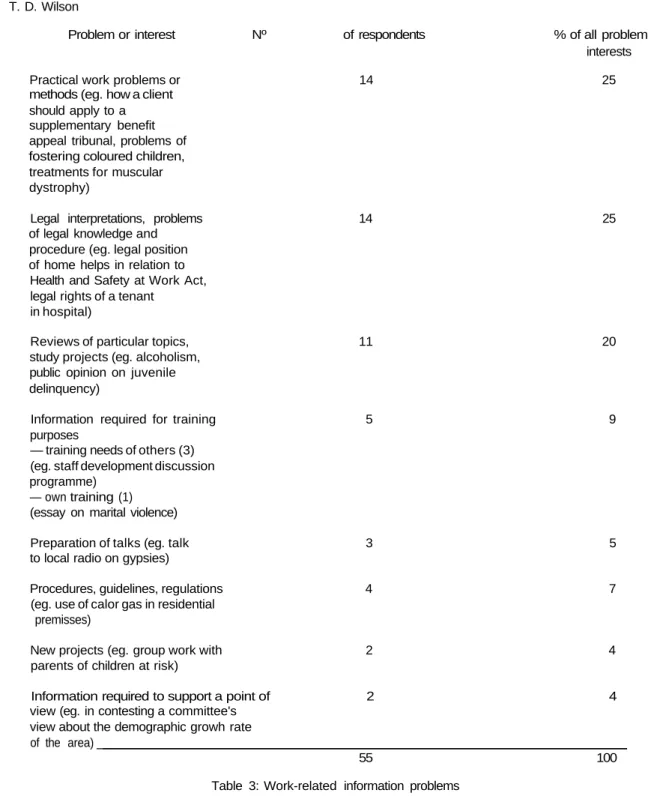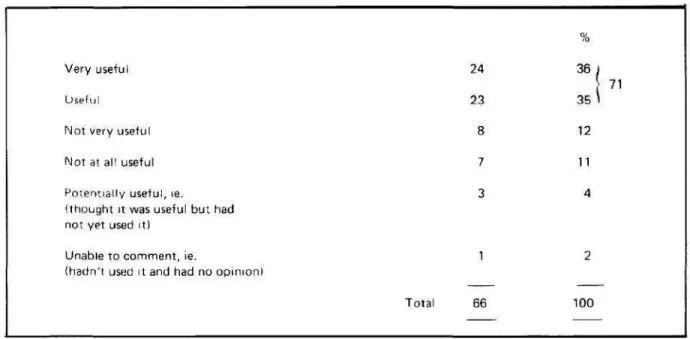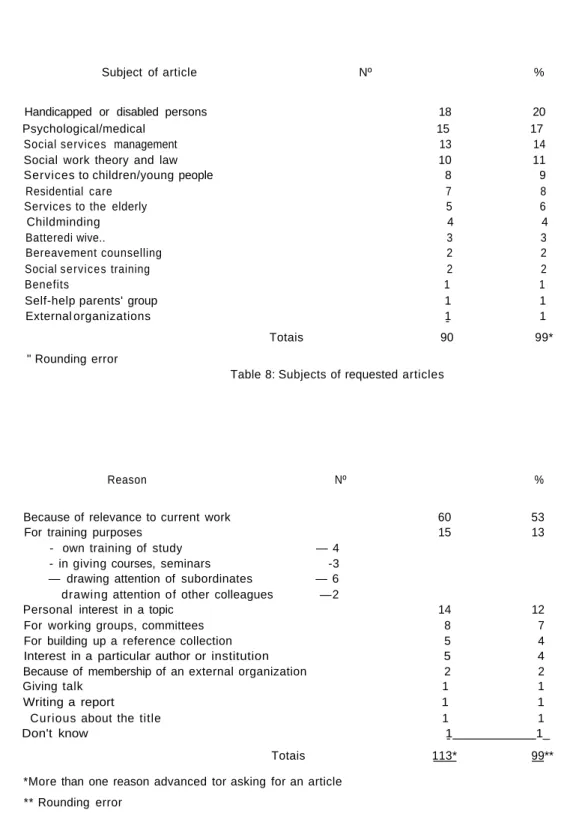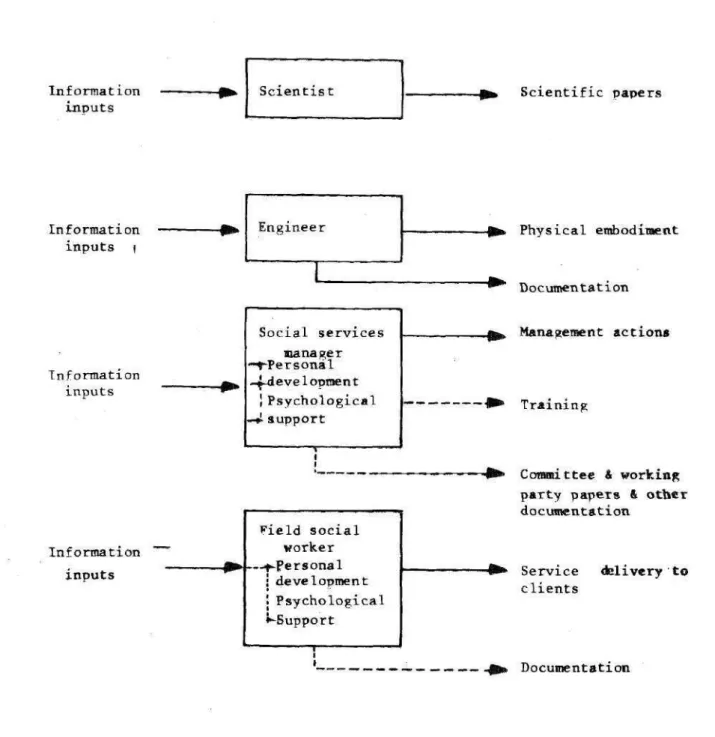SERVICES DEPARTMENTS*
T. D. Wilson
Senior Lecturer in Information Studies
Postgraduate School of Librarianship and Information Sciences University of Sheffield
England
ABSTRACT
Discusses, in the context of a user-evaluation of a
current-awareness bulletin, the concept of "information use' It is shown that both the bulletin and the original articles have multiple uses for the readers and that information can be shown to relate not only to cognitive needs but also affective needs.
Descritores: Serviços de alerta; Boletins de informação; Necessidade de informação; Uso da informação; Avaliação; Estudos de usuário.
INTRODUCTION DATA COLLECTION
With all the attention devoted to information-needs and information-seeking behaviour over the last twenty years or more it is a little surprising that so little effort has been addressed to the question 'How is information used? What purpose or purposes does it serve for the information user?' The answers to these questions ought to be closely related to statements of need but such statements have often been couched in terms of the nature of the documents people believe they need. There is much less in the way of case material on the purposes served by documents acquired to satisfy needs. In the course of a major investigation into information needs in social services departments (1) it became possible to evaluate several aspects of a current-awareness bulletin produced for social services staff (2). A
user-evaluation survey was carried out and some of the results of this survey are reported in this paper. * Trabalho apresentado na IRF1S3, Oslo, Agosto 1979.
Publicação autorizada em carta de 6 de setembro de 1979.
Interviews were conducted with 82 recipients of the bulletin: 66 in two social services departments, 10 in a university school of social work, and 6 in Area Health Authority. This paper is based on the interviews with social services staff who were distributed over work roles as in table 1.
Directorate Specialists/advisers Line managers Field workers Administrative support N % 4 13 22 15 12 66
6
20
23
23
18 100Table 1: Work roles of respondents
The length of interviews ranged from 16 to 64 minutes, (with a median of 34), the interviews with those
T. D. Wilson
who used the document supply service (active users) generally taking about 10 minutes longer than 'passive' users who did not make use of that service.
The interview schedule was divided into four sections: section one sought information on the respondent's work role and specialized interests; section two sought generalized data on the types of information respondents perceived as relevant to their work using a categorization of information types derived from earlier work (3); section three sought case-study material on specific problems using a critical incident approach; and section four dealt with the use of the current awareness bulletin and the use made of copies of journal articles. This last section employed what may be the novel method of producing copies of requested items and asking respondents to recall why they had asked for the items and what use they had served.
RESULTS
This paper will not attempt to report on all aspects of the study but will be restricted to some of the findings from sections two, three and four of the interviews.
Generalized information needs: respondents were
presented with a list of six information types which previous research had shown to be relevant. To test the value of rating versus ranking items
forty respondents were asked to rate the importance of these types and twenty-six were asked to rank them. There was very little difference in the resulting orders of importance and for all respondents the rank order was as shown in table 2. Dept. A respondents were chiefly managers, whereas Dept. B included field social workers.
Information type
Legal information
News of developments in social work Evaluation of ideas and experience Research information
Training information Medical information
Rank order of importance Dept. A(n=16) 1 = 2 = 2 4 5 6 Dept. B(n=50) 1 3 4 5 2 6
Table 2: Significance of information types
Critical incident reports: data such as those given above
tells us something about information needs but the description is very bald. To flesh it out, to give it some substance and relationship to the work performed by the respondents requires case material. In this investigation the case material was provided by asking the respondent to recall a problem or interest for which information produced outside the department was found to be relevant. Fifty-five usable responses were obtained, the remainder being nine who were unable to recall such a problem or interest and two recalled the use of internally-generated information.
The problems or interests cited by respondents fell into the categories shown on Table 3 chief of which
were practical work problems or methods (25% of respondents) and legal interpretations or problems of legal knowledge and procedure (25%). Examples included:
"A problem related to legal interpretation of a new clause relating to the 1975 Children Act. I found that all current opinion was inconsistent with a recent High Court judgement... (This) has a direct bearing on the sorts of decisions I am having to make"
"We were considering proving some sort of group work for parents of children at risk, a fairly new development and we found that there was very little information'.
T. D. Wilson
Problem or interest Nº of respondents % of all problems/ interests Practical work problems or 14 25 methods (eg. how a client
should apply to a supplementary benefit appeal tribunal, problems of fostering coloured children, treatments for muscular dystrophy)
Legal interpretations, problems 14 25 of legal knowledge and
procedure (eg. legal position of home helps in relation to Health and Safety at Work Act, legal rights of a tenant
in hospital)
Reviews of particular topics, 11 20 study projects (eg. alcoholism,
public opinion on juvenile delinquency)
Information required for training 5 9 purposes
— training needs of others (3) (eg. staff development discussion programme)
— own training (1) (essay on marital violence)
Preparation of talks (eg. talk 3 5 to local radio on gypsies)
Procedures, guidelines, regulations 4 7 (eg. use of calor gas in residential
premisses)
New projects (eg. group work with 2 4 parents of children at risk)
Information required to support a point of 2 4 view (eg. in contesting a committee's
view about the demographic growh rate of the area)
55 100 Table 3: Work-related information problems
Table 3 shows clearly the wide range of job-related use of documentary information sources figured activities engaged in by practitioners in sociaj significantly in the respondents information-seeking services departments and the associated uses to behaviour (Tables 4 and 5). It appears that
which information can be put. Given the results of when presented with a service specifically designed our earlier research and our studies in departments to meet these interests the staff of social services which did not have the use of a current-awareness departments are as ready to use documents as those bulletin it is interesting to discover that in these in other, more research-oriented work roles, departments use of the bulletin as a searching tool and
T. D. Wilson
Nº of respondents" % of all
methods No deliberate search - the information
happened to arrive when the issue was current
Methods used in looking for information
Used SWIB (looked through bulletin and ordered photocopied articles)
Asked colleagues, professional or informal contacts, advisers
Contacted outside organisations eg. DHSS, Age Concern, other LA's
Used country library (including library information desk at local government HQ) Used personal reference collections in a
variety of forms - books, handouts, photocopied journal articles including SWIB items
Carried out a strategic search eg scanning press, following-up book and journal references. University Medlars service
Consulted specific documents eg DHSS handbook, Clarke, Hall and Morrison
Used research and development office Contacted other departments within the local authority eg. Treasurer s department
Bought, or attempted to buy, a book Used own copy of journal
Used office or departmental reference collections Used SCAN/Weekly Annotations Service Wrote to a hospital
Attended a rent tribunal
87 97*
More than one method given per respondent (55 respondents) "'Rounding error
Table 4: Methods of seeking information
Ci. Inf., Rio de Janeiro, 8 (2): 101 - 112, 1979 104
21 1-0 10 9 9 8 7
6
5
3 3 2 2 1 1 9 189
9
9
8
76
5 4 3 3 2 2 1 1T. D. Wilson
Search continuing
Information found to be useful Journal articles
Government publications Publications of associations, pressure groups eg. NACRO, National Development Group for Mentally Handicapped Research papers, reports including internal reports and reports of other LA's
Oral information, experience of others, reports of colleagues' readings on a subject
Training course handouts and lectures Books
Newspaper articles, including Time's law reports
Statistics
R & D file on subject Local accommodation list NSPCCfileon client Details of a salary scale Letter from hospital in reply to written request for information
N9 of respondents* 3 28 12 7 7 6 4 4 3 1 1 1 1 1 1 77 'More than one form given per respondent (55 respondents) **Rounding error
Table 5: The information found to be useful
Ci. Inf., Rio de Janeiro, 8 (2): 101 - 112, 1979 105 % of all forms oi information 36 16
9
9 85
5
4
1 1 1 1 1 1 98**T. D. Wilson
Use of current awareness bulletin: respondents were asked how useful they found the current awareness bulletin and replied:
Table 6: Usefulness of the bulletin
The reasons given for finding the bulletin 'useful' or 'very useful' are of interest because they draw attention to a range of uses which, although recognized by information scientists, have rarely had empirical support from users of services. Table 7 lists these 'uses' and quotes statements from respondents: more than one kind of use was
reported by some respondents.
No doubt if these freely-given responses were • subsequently used as response categories in another
study a different pattern of responses would result and it is interesting to speculate how significant the one psychologically-motivated response ('Reduces feelings of isolation') would be in
geographically-distributed organizations like social services departments.
Use made of specific articles: the kind of results
reported on page (102) above as 'generalized information needs are perhaps typical of user-needs
investigations. Clearly, when broken down by
the work-roles of respondents, these results may direct the information provider's attention to categories of information which should be
given priority in the dissemination process (for example, by producing specialized, thematic services). However, such results fail to indicate the specificity of
subject interests and do not reveal how information is used.
To investigate these issues those respondents who were known to have requested articles through the
service {or who in the course of the interview were discovered to have done so) were shown copies of articles and were asked:
a) Can you recall getting this item? b) Why did you ask for it? c) What use did it serve?
Ninety articles were examined in this way with the results shown in Tables 8 to 10.
T. D. Wilson
Reasons for usefulness of SWIB Nº of responses %
1. TIME-SAVING, through SIFTING items 19 23
of interest from a large number of journals
Examples:
"It's a single point for access to the literature"
"Because it does away with the need to handle numerous journals"
2. COVERAGE of the field 18 22
Examples:
"It's information we dont' receive any other way"
"I don't get the same selection of material from any other source".
3. UPDATING or CURRENT AWARENESS function 18 16
Examples:
"It brings to my attention articles that are up-to-date".
". . . it shows the way people are thinking. . ."
4. The ABSTRACT being a convenient summary 10 12
Examples:
"It provides a precis of research done". "Because it is a convenient summarising of items not immediately available"
5. It PROMOTES IDEAS 9 11
Examples:
"... reading it through jogs you,
because especially in our work we are very busy with day-to-day routine".
6. Helps the individual to KEEP IN TOUCH 8 10 and REDUCES FEELINGS OF ISOLATION
Examples:
"I'm fairly isolated over here, so there's a tendency to get on with one's fob without getting much stimutation from elsewhere ".
"It keeps me in touch. . . the further up you go the more remote you become"
7. It's usefulness in TRAINING 5 6
Example:
"When one has students you need to tell them where to go for things, or when one gives talks one needs to give a variety of slants".
82 100 Table 7: Reasons for the usefulness of SWIB
T. D. Wilson
Subject of article Nº %
Handicapped or disabled persons 18 20 Psychological/medical 15 17 Social services management 13 14 Social work theory and law 10 11 Services to children/young people 8 9 Residential care 7 8 Services to the elderly 5 6 Childminding 4 4 Batteredi wive.. 3 3 Bereavement counselling 2 2 Social services training 2 2 Benefits 1 1 Self-help parents' group 1 1 External organizations 1 1 Totais 90 99* " Rounding error
Table 8: Subjects of requested articles
Reason Nº %
Because of relevance to current work 60 53 For training purposes 15 13
- own training of study — 4 - in giving courses, seminars -3 — drawing attention of subordinates — 6 drawing attention of other colleagues —2
Personal interest in a topic 14 12 For working groups, committees 8 7 For building up a reference collection 5 4 Interest in a particular author or institution 5 4 Because of membership of an external organization 2 2 Giving talk 1 1 Writing a report 1 1 Curious about the title 1 1 Don't know 1 1_
Totais 113* 99** *More than one reason advanced tor asking for an article
** Rounding error
Table 9: Reasons for asking for an article
T. D. Wilson
Use made of an article N9 % of uses
Not useful or not particularly usefu 14 —
Added to, clarified or confirmed own 48 51 knowledge, opinions or ideas
— supplemented or broadened knowledge - 28 of general interest or for current
awareness
— confirmed own ideas - 1C — validated prior act - 2 — provided comparison with ideas
practice of others - 8
Contributed to a specific task 13 14 - writing report - 2
- writing essay - 1 - preparing lecture _ 2 - preparing play _ 2 — quoted in a meeting _ 5 — basis for a project _1 Training and personal development
Information passed to colleagues Kept for reference
Gave practical guidance (how to do something) Information passed to clients
Provided "security"
Personal interest, not job-reiated "Not sure what I was looking or "Can't recall"
Totals *More than one use oer item
*" Rounding error
Table 10: Use made of articles
9 8 7 3 2 2 1 1 1 95* 9 8 7 3 2 2 1 1 1 9 9 * *
T. D. Wilson DISCUSSION
The data reported here were collected for the purpose of evaluating a particular current-awareness
bulletin, so that the producers could be guided in their selection of material and so that a more firmly-based case could be made to
institutional managements for the continuation
arid development of the bulletin. It will be clear, however, that the data can be used to illuminate some
theoretical issues of information use.
T. J. Allen has drawn attention to the fact that engineers and scientists put information to different kinds of uses: the scientist puts
information to use in producing further information, the engineer produces artefacts and documentary information (4). The analysis is a little
over-simplified, perhaps, but it provides a useful model, capable of further development. Figure 1 shows Allen's model for scientists and
engineers together with an elaboration for social services managers and field-workers. The fact that the representations are more complex for the latter roles does not mean, necessarily, that the complexities do not exist for the former. It simply means that they are more
directly drawn to the attention of the researcher and, therefore, may be of greater significance to the information-seeking and information-using behaviour of people occupying those roles.
It has been suggested that the determining factors of information need are work-role, levei of performance of that role, and environment (among other things) (5). The same can be said in the case of information use, bearing in mind that information may be sought in order to answer perceived needs or that the information that comes to hand may create awareness of a need. Whichever of .these avenues leads to information use it seems clear that the use to which information is put will depend upon the same factors. Although we have not yet analyzed the data by work role and other factors it seems
that the following hypotheses would be worth testing: 1. the higher a person's organizational status, the wider
the range of uses to which information may be put;
2. a person will use information to reduce feelings of isolation if he is geographically separated from others, or if he is organizationally separated (ie. if his status sets him apart);
3. a person will use information to create a feeling of security if his work role places him in a supervisory position over specialist workers;
4. a person is more likely to use information to update his knowledge of a field if:
a. — he is required to perform a specialized role in the organization;
b. — he is required to perform an advisory role in the organization;
c. — he is required to perform a training role in the organization; or if;
d. — he perceives his role as carrying an informal training function (as in the case of
supervisors of basic-grade social workers). Another aspect of information use which these findings draw attention to is that-even for one individual the same document may serve multiple uses. Thus, a document may be asked for initially out of a general interest in the subject but, having satisfied this use, may be referred to in a meeting, passed on to a subordinate, or retained for further use in the future. Thus, the 76 documents which were actually found to be useful (Table 10) received, on average, 1.25 uses each. The concept of multiple benefits arising from a single item of information is of considerable importance, although respondents were generally unable (or unwilling) to talk of benefits in terms of money or time
saved, which makes the task of employing cost/benefit analysis extremely difficult. When this issue was pressed with a number of the respondents the general tendency was to state that, had the information been unavailable, they would have done without and could not speculate on the consequences.
In one of the departments the research also cast some light on a factor that affects the usefulness of an SDI service. Staff in that department had been provided with an SDI service before the introduction of the bulletin, at which time the SDI services ceased. Respondents in this department were asked which type of service they preferred and, of the sixteen people involved, twelve preferred the bulletin, three the SDI service and one thought there was no difference.
The reason for preferring one service rather than the other seems to have been related to the ability of an individual to identify a limited range of interests for the SDI service, since those who liked that service made comments like:
"It was easier to handle... more sifting had been done".
whereas the commonest kind of response from those who preferred the bulletin related to receiving more 'pink sheets' than they could cope with, for example:
"SDI was 'over-kill'. I was quite pleased to go over to the bulletin. It was difficult to construct a profile... you'd get a great wad of pink sheets which were difficult to go through".
T. D. Wilson
Figure 1: Information inputs and associated outputs for
different work-roles
T. D. Wilson
This suggests that, if the user can select items quickly from a small bulletin the information is more likely to be put to use.
The fact that profile-construction may be a general problem in social services is suggested by
further work we have been carrying out on another project (6). As part of the process of introducing innovations into departmental information systems social workers are being asked to identify their interests using the SWIB subject-heading list. Thirteen respondents have now submitted responses and, from a list of 219 headings, the average number selected by each respondent is 71 (with a range of 8-126). In other words the
scale and generality of social welfare is so great as to render an SDI service inappropriate for most people. This points to the general danger of introducing
into totally different settings methods based on the work-roles and information-seeking behaviour of research scientists and engineers.
ACKNOWLEDGEMENTS
I am grateful to Gill Francis, research worker on Project LOG I for filling in some of the gaps in the data and to both her and Christine Mullings, principal
investigator on Project LOG I for reading and commenting upon this paper, Judith Dunn, research worker on Project INISS provided the data in the final paragraph.
REFERENCES AND NOTES
1 Project INISS, funded by the B L R & D Department from 1975 to 1978. See: Wilson, T D and Streatfield, D R Information needs in local authority social services departments: an interim report on Project \N\SS.' Journal of Documentation
33 (1977) 277-293 and Wilson, T D, Streatfield,
D R and Mullings, C 'Information needs in local authority social services departments: a second report on Project INISS.' forthcoming in
Journal of Documentation.
2 The Social Work Information Bulletin, produced
cooperatively by Leicester Libraries all
Information Service, Leicester University, Coventry Social Services Department, and Derbyshire County Library.
3 See Note 1 above.
4 ALLEN, T. J. Managing the flow of technology. Cambridge, Mass: MIT Press, 1977,
5 WILSON, T.D. The investigation of information needs as a basis for training users in
information use'. International Forum on
Information and Documentation 2: 25—19,
1977.
B A project of information innovations in social services departments (Project INISS, Phase 3) supported by the Department of Health and Social Security.
RESUMO
Dentro do contexto da avaliação do usuário de um Boletim de Alerta Corrente o conceito de "Uso da Informação" é discutido. É demonstrado que tanto o Boletim como o artigo possuem muitos usos para os leitores e que a informação está relacionada não somente às necessidades cognitivas mas também afetivas. (AB).




